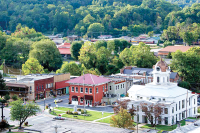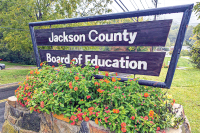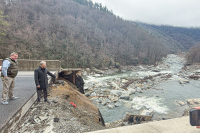Breakaway breezes into year five
 More than 400 riders will push off from Lake Junaluska Aug. 16 for the fifth year of the Blue Ridge Breakaway ride, their routes winding through the curvy, rural roads of Haywood County, with the two longer routes even venturing up to the Blue Ridge Parkway.
More than 400 riders will push off from Lake Junaluska Aug. 16 for the fifth year of the Blue Ridge Breakaway ride, their routes winding through the curvy, rural roads of Haywood County, with the two longer routes even venturing up to the Blue Ridge Parkway.
Resurrecting Graveyard Fields: Blue Ridge Parkway Foundation funds makeover for popular recreation site
 Rhododendrons are opening deep pink blooms along the Blue Ridge Parkway, and new spring foliage blends into a bright blue sky dotted with puffy clouds. At the Graveyard Fields overlook this Friday morning, chirping birds and the occasional passing car are the only sounds. “Idyllic” is the word that comes to mind, but this peaceful scene is far from the norm for this pull-off near mile marker 418.
Rhododendrons are opening deep pink blooms along the Blue Ridge Parkway, and new spring foliage blends into a bright blue sky dotted with puffy clouds. At the Graveyard Fields overlook this Friday morning, chirping birds and the occasional passing car are the only sounds. “Idyllic” is the word that comes to mind, but this peaceful scene is far from the norm for this pull-off near mile marker 418.
Smokies and Parkway open to windshield tourists only
 The impasse at the federal level will touch all areas of operation at the Great Smoky Mountains National Park and Blue Ridge Parkway, closing picnic areas, campgrounds, bathrooms, visitor centers and historic sites.
The impasse at the federal level will touch all areas of operation at the Great Smoky Mountains National Park and Blue Ridge Parkway, closing picnic areas, campgrounds, bathrooms, visitor centers and historic sites.
Unlocking the mystery of Graveyard Fields: Why there are so few trees and so many people
 While lines of cars zip down the Blue Ridge Parkway and hikers scurry along its zigzagging trails, Graveyard Fields moves at its own pace.
While lines of cars zip down the Blue Ridge Parkway and hikers scurry along its zigzagging trails, Graveyard Fields moves at its own pace.
The high elevation meadows of Graveyard Fields are a crowned jewel of the Shining Rock Wilderness. No trees means great views — views without scrambling up a mountain peak or peering out from intermittent windows in the tree canopy.
“Tunnel-phobia” has gotten worse as years go by
 Leading a field trip isn’t complicated. But there may be more to it than you suppose. It helps if you know ahead of time where you’re going to make stops; where to eat lunch; and where the bathrooms are situated.
Leading a field trip isn’t complicated. But there may be more to it than you suppose. It helps if you know ahead of time where you’re going to make stops; where to eat lunch; and where the bathrooms are situated.
High peaks offer the last vestige for vanishing cool-climate species
 The fight for survival is nothing new for high-elevation species in Southern Appalachia.
The fight for survival is nothing new for high-elevation species in Southern Appalachia.
After the glaciers receded at the end of the last Ice Age 10,000 years ago and temperatures warmed, remnants of a cold-weather forest in southern Appalachia were forced high up the mountain slopes. There, they hung on to small, ever-shrinking islands in the upper reaches of the Smoky Mountains — where the coniferous trees on the high peaks more closely resemble southern Canada than North Carolina.
Bicycle touring light Overnight trips take the pressure off planning, purchasing
 By Jack Moore • Contributor
By Jack Moore • Contributor
J.R.R. Tolkien wrote, “Not all those who wander are lost,” and he may as well have been writing about bicycle tourists. This time of year in the Smokies it’s not uncommon to see a cyclist, bike loaded with gear, struggling up and over one of our many mountain passes.
You might imagine they are on some grand adventure circumnavigating the globe or at least crossing the country in some epic voyage. You may be right, or it could be that this is one of your cycling neighbors out for a short overnight bicycle camping trip.
Future park might be in the cards for the Plott Balsams
The recent acquisition of 720 acres of land in the Plott Balsams has helped set the table for the first major park to be created along the Blue Ridge Parkway in six decades.
The land, owned by former Congressman Charles Taylor, was recently taken over by the national group The Conservation Fund. That same group has a two-year option for 2,226 more acres but will need to raise some $5.7 million to make the purchase.
The pieces of property help make up Maggie Valley’s watershed. Neil Carpenter, head of the sanitary district for the town, said the recent purchase was a relief. He’s worked at preserving the land from development for the past eight years.
“Development was a possibility,” Carpenter said. “The economy slowing down bought us some time. If the economy had kept booming, I think it would have sold for development. We’re ecstatic it’s protected now.”
The town pulls its water from Campbell Creek. There are 10,000 users on Maggie Valley’s water system, Carpenter said.
The property is extremely rugged but could still have been developed, Carpenter said. Under Haywood County regulations, one house could have been built per each half acre available.
“That was a big threat,” Carpenter said, adding that development could have required the town to engage in “difficult and costly water treatment” down the road.
“And once that quality of a stream is compromised, you virtually never get back to that original quality,” he added.
The land, which connects to 2,415 acres adjacent to the Blue Ridge Parkway that have already been purchased, run along the 6,000-foot high crest of the Plott Balsams near Sylva and Waynesville. They lie to the west and east of the 6,200-foot high Waterrock Knob, a major scenic destination on the Blue Ridge Parkway.
“The goal is to take all these conserved lands and make a park out of them,” Carpenter said. “And to make a wildlife corridor.”
The towering Plott Balsams are ecologically significant. Elk from Cataloochee have shown up there, plus the land is home to the Carolina Northern Flying Squirrel and populations of native brook trout.
What the future holds
In the 1950s, three other parks were established along the Blue Ridge Parkway: the 3,512-acre Moses Cone Park near Blowing Rock, the 4,264-acre Julian Price Park that is adjacent to the Moses Cone Park, and the 1,141-acre Linville Falls Park.
Each of these parks was created via financial gifts from individual families. And, the mold appears unbroken in this case, too — the property being acquired today along the parkway has, so far, been paid for with money from Fred and Alice Stanback of Salisbury, who have been important philanthropists in the environmental arena for years. Federal funding is being sought to help pay for the remaining available parcels. Meetings already have taken place with U.S. Sen. Richard Burr about the possibility for federal funding efforts.
Phil Francis, superintendent of the Blue Ridge Parkway, said the recent acquisition is key to helping protect the views for visitors.
“I think that’s a very important piece for the protection of our viewsheds,” Francis said, pointing out that this is in line with Haywood County’s proactive stance in this area.
The Haywood County Tourism Development Authority and Maggie Valley Lodging Association recently earmarked $19,500 to clear a portion of the county’s 73 vistas along the Blue Ridge Parkway. The money was used to hire three workers, or fallers, in February to begin scaling back the overgrown trees.
“This will further help protect these views,” Francis said, adding that the Plott Balsams holds “a rich array of resources.”
Francis said a future park along the Blue Ridge Parkway is not inconceivable and that it is within the agency’s scope to manage such an entity if formed. The 469-mile parkway currently has 15 different recreation areas.
“If all the arrangements can be worked out, we could manage a park,” Francis said. “That’s always a big ‘if’ however.”
Francis, who has been involved in the meetings about securing the remaining tracts of land, said he’s been impressed by the commitment of the parties involved to protect the Plott Balsams.
Cutting campaign restores Parkway vistas
Visitors to Haywood County will have a fuller view of its mountain beauty this year after a locally funded project left some of the Blue Ridge Parkway vistas a bit barer.
The Haywood County Tourism Development Authority and Maggie Valley Lodging Association earmarked $19,500 to clear a portion of the county’s 73 vistas along the parkway. This is the first year that the tourism agency has taken it upon itself to help preserve the panoramic overlooks that permeate Haywood County.
“The Blue Ridge Parkway is one of our treasures, our jewels,” said Susan Knapko, a member of the tourism board. “Grab you kids, your husband, a picnic, and come look at this.”
The TDA hired three workers, or fallers, in February to begin scaling back the overgrown trees enshrouding some of the county’s most popular and majestic views.
“This is our backyard right here,” said Joanne Martin of the Maggie Valley Lodging Association. “We felt it was a very wise investment.”
The association often directs visitors — a number of whom are motorcycle enthusiasts — to the parkway and its breathtaking views. Without the fallers, trees would shield those views.
While overlooks were a hallmark of the parkway when it was constructed, views have been obscured in the intervening the decades. The parkway hasn’t have enough money to properly clearing them every year, prompting action by the Haywood County tourism agency to take matters into its own hands.
Haywood County is home to more 6,000-foot peaks than anywhere else on the Eastern seaboard. Its section of the Blue Ridge Parkway is likewise the highest elevation stretch of the 469-mile scenic journey from Shenandoah in Virginia to the Great Smoky Mountains.
As of April 2, the trio had cleared 23 vistas in Haywood County and hoped to clear at least a few more by the end of the week, when their contract with the county expires and their work for the Blue Ridge Parkway starts.
“It’s really a good investment by the community helping us keep our views cleared,” said Phil Francis, superintendent of the Blue Ridge Parkway. “People come to the parkway over and over, and they notice the difference.”
Francis added that he hears complaints about the overgrown trees that crop up and inhibit visitors’ ability to enjoy particular sights.
“As the parkway has gotten older and the trees have gotten taller, it has been a challenge to keep up with maintaining those views,” Francis said. “The plant material grows up too fast.”
The parkway has launched a campaign of its own to clear overlooks on a more regular schedule.
“Every three years is not what we would prefer. It’s what we can afford,” Francis said.
The three fallers will join the parkway’s payroll next Monday and continue clearing vistas throughout Western North Carolina until late September.
The Haywood County TDA money “allowed us to get a head start,” said Chris Ulrey, one of the fallers.
The Blue Ridge Parkway also contracts seven other people to clear some of the roads more than 100 vistas in North Carolina. The contract is $235,000.
A light touch
Clearing clutter from the vistas’ views is not as simple as it may sound. Workers must be deliberate in which trees to cut down and consider the wildlife that lives in the forest surrounding the Blue Ridge Parkway.
The fallers must first survey each vista and see which trees they should cut and which they should prune. They descend the steep slopes down from the overlooks and use chain saws to either trim limbs or hew a tree. If possible, the workers get the tree to fall downhill. The trees then become home to some forest critters and deposit nutrients in the ground as they decay.
While workers used to clear all the trees blocking people’s view, fallers now leave a tree or two here and there for the Carolina Northern Flying Squirrel, an animal found only in the Southern Appalachians. The squirrel travels by gliding from tree to tree so workers now leave some still standing to preserve the species’ habitat.
Although the workers will conclude their stint for Haywood County Friday, some earmarked funds remain unused. It is unknown how much of the $19,500 was spent, said Lynn Collins, executive director of the TDA. But, the leftover money will allow the TDA to rehire the three fallers to trim and cut down trees for a few weeks in October before the weather typically becomes too harsh, she said.
The TDA board debated whether it would be a good idea to keep the fallers working into October, a high point in the tourist season. However, members decided that visitors would likely enjoy seeing a picturesque view open up before them as the workers lop down trees.
“It is so exciting to actually watch these guys go down the mountain sides with chain saws,” Knapko said. “The crew themselves have been so thrilled.”
The tourism board plans to continue the vista project after this year. At a recent meeting, board members discussed finding donors to sponsor the work and possibly allocating a set amount of tourism dollars to the project each year.
Foundation gives in big way to parkway
Blue Ridge Parkway Foundation has given more than $650,000 to the Blue Ridge Parkway for projects and programs this year.
These cover a range of initiatives, including children's education, projects to enrich the visitors' experience and preservation of historic, cultural and natural resources along the length of the parkway.
"The support provided by the foundation has become vital to our ability to meet some of the parkway's most basic needs and maintain a sustainable and healthy Blue Ridge Parkway," Parkway Superintendent Phil Francis said.
Among the projects funded by the money:
• Continued funding of the Parks As Classrooms initiative for this school year.
• Graveyard Fields Enhancement project, to improve visitor use and stewardship of this highly trafficked area and expand the parking, construct a convenience station and improve the trails and interpretive signs.
• Waterrock Knob Visitor Center Roof Replacement. A total roof replacement of the Waterrock Knob Visitor Center that has been in a state of deterioration for a number of years.
• Blue Ridge Parkway Weather. The Blue Ridge Parkway will partner with Ray's Weather and Appalachian State University to build a comprehensive weather website and smart-phone application covering the entire Blue Ridge Parkway. Using information from weather stations and webcams installed along the parkway, the site will include custom forecasts, live weather conditions, live webcam images and video, radar and satellite imagery, climate information and reader supplied photography and comments. Data from the site will be freely available to researchers in a standard format for projects ranging from park management to research in climate/meteorology, education/outreach, ecology, biology, etc.
A complete list of the approved projects for 2012 can be found on the foundation's website at www.brpfoundation.org/sites/default/files/Publications/Grants2012Sheet.pdf









